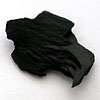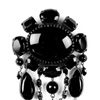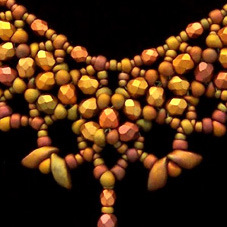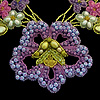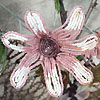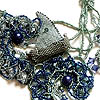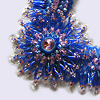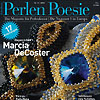November, 2011

Holiday Season is coming!Read in the current November issue:
Jet - mineraloid of organic origin
Contact us with any questions at
info@mylovelybeads.com.
New in Fashion Colorworks 2012 From theatrical costumes to art jewelry Funeral beaded wreaths and flowers Looking for inspiration - Orna Voloh Perlen Poesie Magazine. Issue 11 Step by step - Paisley pattern December upcoming events Best regards, MyLovelyBeads.com Team
|
Jet - mineraloid of organic originJet (lignite or gagat) is not considered a true mineral, but rather a mineraloid as it has an organic origin, being derived from decaying wood under extreme pressure. The English noun "jet" derives from the French word for the same material: JAIET. Jet is either black or dark brown, but may contain pyrite inclusions, which are of brassy color and metallic luster. The adjective "jet-black", meaning as dark a black as possible, derives from this material. Jet is a product of high pressure decomposition of wood from millions of years ago, commonly the wood of trees of the family Araucariaceae. The jet found at Whitby, England is of early Jurassic (Toarcian) age, approximately 182 million years old. Jet is easily polished and is used in manufacturing jewelry, according to the Whitby Museum, dating from 10,000 BC in parts of Germany. The oldest jet jewelry was found in Asturias, Spain, dating from 17,000 BC. Whitby jet was a favorite material for ornamental jewelry during the Roman period, when it was described by Solinus. Hair-pins, rings, spindles, bracelets, and necklaces were produced in great variety, much of it at Eburacum (modern York). In the Roman period jet was frequently used as a "magical" material in amulets and pendants because of its supposed protective qualities and ability to deflect the gaze of the evil eye. Furthermore, Pliny the Elder suggests that "the kindling of jet drives off snakes and relieves suffocation of the uterus. Its fumes detect attempts to stimulate a disabling illness or a state of virginity." Jet as a gemstone was fashionable during the reign of Queen Victoria, during which the Queen wore Whitby jet as part of her mourning dress. Jet was associated with mourning jewelry in the 19th century because of its somber color and modest appearance, and it has been traditionally fashioned into rosaries for monks. In the United States, long necklaces of jet beads were very popular during the 1920s, or Roaring Twenties, when women and young flappers would wear multiple strands of jet beads stretching from the neckline to the waistline. In these necklaces, the jet was strung using heavy cotton thread; small knots were made on either side of each bead to keep the beads spaced evenly, much in the same way that fine pearl necklaces are made. Jet has also been known as black amber, as it may induce an electric charge like that of amber when rubbed. |
|
New in Fashion Colorworks 2012Fashion Colorworks entry must use the three colors in one of the palettes shown on the contest page, in any combination. There are three color palettes and three categories for entries:
• Seed Bead Jewelry: Entries include jewelry and jewelry-related objects. Each entry must be not less than 50 percent seed beads.
There are no entry fees, the contest is open to participants
worldwide, and judging is by photographs. This year in addition
to the awards for the First, Second and Third places in each
category we added five more prizes:
Fofinhas Perlenshtuebchen
is sponsoring three special prizes 50 euros each:
• Finished Jewelry: Each entry must be less than 50 percent seed beads; and other materials such as, but not limited to, glass beads, crystals, semi-precious stones, wire, metal clay, found objects, etc. • Seed Bead Objects: Entries include any not jewelry-related objects, accessories and sculptural objects. Each entry must be not less than 50 percent seed beads.
• Best Newbie;
and
Perlen Poesie Magazine
is sponsoring two "Perlen Poesie Pick" prizes - free
annual subscriptions to Perlen Poesie Magazine.
• Best Mini; • Most Original; Application with attached pictures of entries is sent trough provided online form. Entries are accepted since April 1, and the last submission day is June 15. Read all the details of the contest, including how to enter, and then get busy beading! |
|
From theatrical costumes to art jewelry
We are glad to introduce you Marsha Wiest-Hines, a beadwork artist living and working in Minnetonka, Minnesota, USA. Personal adornment and expression of character through clothing has been her life-long interest, she has been creating wearable art for 40 years in the form of theatrical costumes for the stage, competition clothing for ballroom dancers, and most recently, art jewelry and accessories. In 2007 Marsha discovered bead weaving and fell immediately in love. Marsha says, "I began beading in 2007, when a friend gave me a strung bracelet for my birthday. My wrist is ridiculously small, and the bracelet was very big. I thought, how hard can it be to make it smaller? I went to the bookstore, to find a book to tell me how to adjust the size of the bracelet and next to "Beading for Dummies" there was "500 Beaded Objects." I fell instantly in love and knew I wanted to DO THAT! Beading is a creative outlet/hobby/meditation for me, although I do sell my work. I have an Etsy shop and have sold through several local galleries, my favorite being Minnetonka Center for the Arts, where I currently am selling some of my work in their Arts of the Holidays show. This was one of my very first efforts, done as a color study and an exploration of the bead textures and finishes. I was very proud of working out the little violet flower and leaf for myself. I have used this leaf technique in my "Mom's African Violets", with some refinement ever since! For example, this leaf uses the same technique, although somewhat refined by the addition of cylinder beads to the seeds ("The Last Leaf"). I find myself a competitive person by nature, and some of my favorite work has been created with a competition in mind. This was my first effort at an entry to the Bead Dreams competition, and one of my all time favorites. Needless to say, I have never managed to get an entry accepted at Bead Dreams! I sold this piece ("Sticks and Stones") and I miss it! I became a member of the Etsy Beadweavers Team just as I was making "Sticks & Stones" and several of my other favorite pieces were created for the team challenges. This Bollywood Beauty Necklace won our Bollywood Challenge last year, and this necklace "Ash and Ember - the Balrog" won the Lord of the Rings Challenge last spring. I was fortunate to have the opportunity to work with fellow beadweaver and lampworker Hannah Rosner. I won a competition through "One Stop Bead Shop" that required the use of some of her beads, which I thought were beautiful and inspiring (INK Necklace)!"
Full article by Marsha Wiest-Hines
|
|
Funeral beaded wreaths and flowersMan has always tried to keep alive the beauty of a flower through a variety of available materials. Creating flowers using beads and wire, which originated in ancient times among the French peasants (so the beginning of this craft has not been documented), takes its exceptional place because beaded flowers are truly lovely bubbly! For a long time, knowledge about this art handed down orally from generation to generation, it is known that this type of beading was developed in other European countries: England, Italy. In the 19th century, adorning clothes with beads and beaded accessories were widespread among nobility, and the remnants of beads were often used by female workers to make three-dimensional flowers for their rooms and church altars decoration. Around the same time glass beads were used for weaving funeral wreaths. The reason was simple: fresh flowers are not available all year round, they could stay live for only a short time, and the flowers of beads in all its beauty were often even cheaper. The story that is directly related to this came from France. |
|
Looking for inspiration
It's a pleasure to have another bead artist, Orna Voloh from Israel in our newsletter! Orna was born in a small town in the Urals, Russia. When she was 20 years old she learned RAW stitch weaving, it was the beginning of her bead career. She has been beading for eight years and then had a big break. Fate decreed that now Orna lives in Israel, in the city of Petah-Tikva. Here she got married, and while "expecting" her daughter a few years ago, she regained inspiration. Orna tells, "In the ninetieth there was no Internet and beads in the shops, too, but my friends discovered that I "knew how to weave beads" and carried me already torn and useless beaded necklaces, one could bring a little bit, another - a bit more! I was happy to each such a thing as to a heap of countless treasures, and enthusiastically wove. Tiny beads had an incredible ability to form a pattern, each of which received a special meaning in my eyes and the eyes of my friends - in fact, beads still returned to my "sponsors" - as unpretentious trinkets. I did not know then how to weave according to the "bead science," I couldn't learn from anyone because there were not teachers and any classes. I invented everything by myself - stitches, patterns, etc. I dealt with what can be called "reinventing the wheel", and now I use my developments of that period, which lasted eight years. I dedicated five years to work with children teaching them what was already known to me and what I could make, and then I had a big break. Fate decreed that I live in Israel, in the city of Petah-Tikva. Here I got married, and while "waiting" for my daughter, I regained inspiration. I saw how much Internet allows for new beading ideas, and realized that I needed to go back to my youthful enthusiasm, especially because buying good materials in Israel was much easier than in Russia. I found out an entirely new world of beads, not what I had known about it before, moreover bead craft was on the rise. Over Internet, I met with beadworks of many great weavers who create masterpieces, and it was an additional impulse for me! I wanted to be just a little closer to their level! Though just a little! And then I found myself in almost complete inability to repeat someone else's work and most importantly to work according stranger's patterns! Perhaps, this is good as a whole, although the independent development of the already known techniques takes more time. Suddenly, from nowhere, in my mind the ideas of my fifteen years ago began to float, and they began to take a completely new form! This primarily affected the traditional techniques I owned and my old designs. I understand that there are no limits in use of beads for creative people, and if there is some kind of an interesting idea, I will sooner or later find a way to implement it. When an idea of another beadwork takes me completely, I sit down and begin to draw a sketch and select materials thinking about embodiments of it and do not stop for a moment. Even in my sleep, I continue to work on the plan. Sometimes the end result is being hatched for months, and sometimes embodied within an hour from the moment an interesting thought flashed through my mind. And I do not know what it depends on!"
Full article by Orna Voloh
|
|
Perlen Poesie Magazine. Issue 11The new issue of Perlen Poesie magazine comes out on December 10th, 2011!
• Lady in RAW.
Marcia DeCoster: The artist is a stylish woman, knits
fine tunics and loves to bead her jewelry mostly in
RAW technique. We met her in Bonn, Germany, where she
held workshops for 3 days. She let us have some of her
treasures, which we are able to show to our readers.
You will also find an instruction for a fancy bracelet...
• The Bead Ambassador. Petra Tismer: She loved beads for a long time and when she accompanied her husband to Turkey for a few years she started to teach beadwork techniques to an international group of women of the diplomatic corps. Back in Germany she turned hobby into profession... • Surprising Designs. Paula Matos: The lively Portuguese woman decided to give up her job in a bank and do what she loved - to design jewelry and to share this love with others. Traveling to India she convinced herself of the bead production... • And 17 instructions. Instructions to rework, for example Micro-Makrame, pieces in Soutache technique, something for the fans of Bead Crochet and inspiration for working with Roses Montee, great pieces in RAW and many other techniques. The magazine is published in Germany by Beaders Best Verlag Company, you can subscribe it. If you live in the USA, you can directly or via Internet buy single issues of the magazine at the Beads by Blanche bead shop. Oh, by the way, the last submission day for the International Bead Award contest sponsored by Perlen Poesie Magazine is December 31, 2011. Hurry up!
Subscribe to Perlen Poesie magazine
|
|
Step by step - Paisley pattern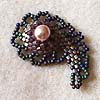
Paisley or Paisley pattern is a droplet-shaped vegetable motif of Indian, Pakistani and Persian origin. The pattern is sometimes called "Persian pickles" by American traditionalists, especially quiltmakers, or "Welsh pears" in Welsh textiles as far back as 1888. This tutorial "How to make beaded Paisley pattern" is prepared for you by Orna Voloh, you can use that in making any jewelry. Good luck! |
|
Upcoming events
December 16-18, 2011 The International Gem & Jewelry Show offers the greatest selection and lowest prices on diamonds, gold, silver, beads, and more. Choose either costume or fine jewelry from more than 350 exhibitors from around the world. |
|
Note
If you don't see the newsletter properly formatted please click here:
November Issue
|
© 2011 MyLovelyBeads.com All Rights Reserved.
If you do not want receive our newsletter and you wish to remove your email address from our mailing list, please click the following link to unsubscribe.



